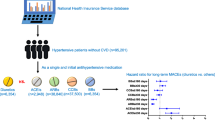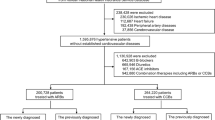Abstract
We studied the profiles of all-cause and cardiovascular (CVS) mortality among users of different antihypertensive classes in a Chinese population. From electronic patient records, a cohort study was conducted among 18 338 patients who ever newly prescribed an α-blocker, thiazide diuretic, β-blocker, calcium channel blocker (CCB) or agents acting on the renin–angiotensin system (RAS) without drug discontinuation or switching in the public primary-care sector in a large Territory of Hong Kong during January 2004–June 2007. The odds ratios of mortality (all-cause and CVS) were evaluated according to the prescribed antihypertensive drug classes by Cox proportional hazards regression analyses. A total of 823 deaths (4.5%) were reported during the study period. The crude proportions of all-cause mortality were highest in α-blockers (6.2%) and CCB (5.7%), but lowest in β-blockers (2.8%). Compared with CCB, patients on thiazide diuretics were shown to have statistically significantly lower all-cause (adjusted hazard ratios (aHRs) 0.75, 95% CI 0.60, 0.93, P=0.010) and CVS mortality (aHR 0.40, 95% CI 0.21, 0.78, P=0.007), but the 95% CI of the odds ratios of the major drug classes overlapped. When each drug class was used as a reference group, or when patients with only uncomplicated hypertension were included, their respective 95% CI similarly overlapped. Antihypertensive drug classes were associated with statistically comparable odds of all-cause and CVS mortality. This finding from real-life clinical practice further supports the position statements from international guidelines, which recommend that the major antihypertensive drug classes are suitable for initiating pharmacotherapy for the management of hypertension.
This is a preview of subscription content, access via your institution
Access options
Subscribe to this journal
Receive 12 digital issues and online access to articles
$119.00 per year
only $9.92 per issue
Buy this article
- Purchase on SpringerLink
- Instant access to full article PDF
Prices may be subject to local taxes which are calculated during checkout
Similar content being viewed by others
References
Kearney PM, Whelton M, Reynolds K, Muntner P, Whelton PK, He J . Global burden of hypertension: analysis of worldwide data. Lancet 2005; 365: 217–223.
Wolf-Maier K, Cooper RS, Banegas JR, Giampaoli S, Hense HW, Joffres M et al. Hypertension prevalence and blood pressure levels in six European countries, Canada, and the United States. J Amer Med Assoc 2003; 289: 2363–2369.
Singh RB, Suh IL, Singh VP, Chaithiraphan S, Laothavorn P, Sy RG et al. Hypertension and stroke in Asia: prevalence, control and strategies in developing countries for prevention. J Hum Hypertens 2000; 14: 749–763.
Singh RB, Five City Study Group. Prevalence and risk factors of hypertension and age specific blood pressures in five cities: a study of Indian women. Int J Cardiol 1998; 63: 165–173.
Ueshima H, Zhang XH, Choudhury SR . Epidemiology of hypertension in China and Japan. J Hum Hypertens 2000; 14: 765–769.
Kearney PM, Whelton M, Reynolds K, Whelton PK, He J . Worldwide prevalence of hypertension: a systematic review. J Hypertens 2004; 22: 11–19.
Wolf-Maier K, Cooper RS, Kramer H, Banegas JR, Giampaoli S, Joffres MR et al. Hypertension treatment and control in five European countries, Canada, and the United States. Hypertension 2004; 43: 10–17.
European Society of Hypertension–European Society of Cardiology guidelines for the management of arterial hypertension Guidelines Committee. J Hypertens 2003; 21: 1011–1053.
1999 World Health Organization. International Society of Hypertension Guidelines for the Management of Hypertension. J Hypertens 2003; 17: 151–183.
Hypertension Management Guide for Doctors. Natl Heart Found Aust 2004; 12: 17.
ALLHAT. The antihypertensive and lipid-lowering treatment to prevent heart attack trial. Major outcomes in high-risk hypertensive patients randomized to angiotensin-converting enzyme inhibitor or calcium channel blocker vs diuretic. JAMA—Express 2002a; 288: 2981–2997.
Wing LMH, Reid CM, Ryan P, Beilin LJ, Brown MA, Jennings GL et al. A comparison of outcomes with angiotensin-converting enzyme inhibitors and diuretics for hypertension in the elderly. N Engl J Med 2003; 348: 583–592.
Brown MJ, Palmer CR, Castaigne A, de Leeuw PW, Mancia G, Rosenthal T et al. Morbidity and mortality in patients randomized to double-blind treatment with a long-acting calcium-channel blocker or diuretic in the International Nifedipine GITS study: intervention as a goal in hypertension treatment (INSIGHT). Lancet 2000; 356: 366–372.
Wilhelmsen L, Berglund G, Elmfeldt D, Fitzsimons T, Holzgreve H, Hosie J et al. Beta blockers versus diuretics in hypertensive men: main results from the HAPPHY trial. J Hypertens 1987; 5: 561–572.
MRC. Medical Research Council Working Party. MRC trial of treatment of mild hypertension: principal results. Br Med J 1985; 291: 97–104.
Lindholm LH, Ibsen H, Dahlof B, Devereux RB, Beevers G, de Faire U et al. Cardiovascular morbidity and mortality in patients with diabetes in the Losartan Intervention For Endpoint reduction in hypertension study (LIFE): a randomized trial against atenolol. Lancet 2002; 359: 1004–1010.
Julius S, Kjeldsen SE, Weber M, Brunner HR, Ekman S, Hansson L et al. Outcomes in hypertensive patients at high cardiovascular risk treated with regimens based on valsartan or amlodipine: the VALUE randomized trial. Lancet 2004; 363: 2022–2031.
Blood Pressure Lowering Trialists’ Collaboration Effects of different blood pressure lowering regimens on major cardiovascular events: results of prospectively designed overviews of randomized trials. Lancet 2003; 362: 1527–1535.
Guidelines Committee 2003. European Society of Hypertension—European Society of Cardiology Guidelines for the management of hypertension. J Hypertens 2003; 21: 1011–1053.
Mancia G . Role of outcome trials in providing information on antihypertensive treatment: importance and limitations. Am J Hypertens 2006; 19: 1–7.
Zanchetti A . Evidence-based medicine in hypertension: what type of evidence? J Hypertens 2005; 23: 1113–1120.
Williams B . Recent hypertension trials: implications and controversies. J Am Coll Cardiol 2005; 45: 813–827.
Hospital Authority Hong Kong. Website available at www.ha.org.hk Accessed on 10 August 2007.
Wong MCS, Jiang Y, Tang JL, Lam A, Fung H, Mercer SW . Health services research in the public healthcare system in Hong Kong: an analysis of over 1 million antihypertensive prescriptions between 2004–2007 as an example of the potential and pitfalls of using routinely collected electronic patient data. BMC Health Serv Res 2008; 8: 138.
Halpern MT, Khan ZM, Schmier JK, Burnier M, Caro JJ, Cramer J et al. Recommendations for evaluating compliance and persistence with hypertension therapy using retrospective data. Hypertension 2006; 47: 1039–1048.
Sever PS, Dahlof B, Poulter NR, Sever PS, Dahlöf B, Poulter NR et al. For the ASCOT Investigators. Rationale, design, methods and baseline demography of participants of the Anglo-Scandinavian Cardiac Outcomes Trial (ASCOT). J Hypertens 2001; 19: 1139–1147.
Turnbull F, Neal B, Ninomiya T, Algert C, Arima H, Barzi F et al. For the Blood Pressure Lowering Treatment Trialists’ Collaboration. Effects of different regimens to lower blood pressure on major cardiovascular events in older and younger adults: meta-analysis of randomised trials. Br Med J 2008; 336: 1121–1123.
Brown MJ . Hypertension and ethnic group. Br Med J 2006; 332: 833–836.
Brown MJ, Cruickshank JK, Dominiczak AF, MacGregor GA, Poulter NR, Russell GI et al. Better blood pressure control: how to combine drugs. J Hum Hypertens 2003; 17: 81–86.
Kaplan NM . Kaplan's clinical hypertension, 9th edn. Lippincott Williams & Wilkins: Philadelphia, USA, 2006.
Chang S, Chan WH, Kong Y, Chan GM, Raymond K, Lee A et al. Use of indapamide in hospital and community clinics and its effect on plasma potassium in Chinese patients. J Clin PharmTher 1998; 23: 295–302.
Yuen YH, Chang S, Chong CK, Lee SC, Critchley JA, Chan JC . Drug utilization in a hospital general medical outpatient clinic with particular reference to antihypertensive and antidiabetic drugs. J Clin PharmTher 1998; 23: 287–294.
Cheung BM, Wong YL, Lau CP . Queen Mary Utilization of Antihypertensive Drugs Study: use of antihypertensive drug classes in the hypertension clinic 1996–2004. Br J Clin Pharmacol 2005; 60: 90–97.
Lam WK, Ho KY, Ng KK, Kwok KH, Tsang LCY . Morbidity pattern in four government general practice clinics using the International Classification of Primary Care (Revised Edition) (ICPC-2) coding. Hong Kong Practitioners 2006; 28: 363–375.
National Collaborating Centre for Chronic Conditions. Hypertension: management in adults in primary care: pharmacological update. Royal College of Physicians: London, 2006.
Ramsay LE, Williams B, Johnston JD, MacGregor GA, Poston L, Potter JF et al. British Hypertension Society guidelines for hypertension management. Br Med J 1999; 31: 630–635.
Chobanian AV, Bakris CL, Black HR, Cushman WC, Green LA, Izzo Jr JL et al. The seventh report of the Joint National Committee on Prevention, Detection, Evaluation, and Treatment of High Blood Pressure: the JNC-7 report. JAMA 2003; 289: 2560–2572.
Wong MCS . Short- and long-term discontinuation patterns of commonly prescribed antihypertensive drugs among a Chinese population: cohort study. J Hum Hypertens 2008; 22: 435–437.
Wong MCS, Jiang JY, Lam AT, Fung H, Griffiths S, Mercer SW . Patterns of antihypertensive prescribing, discontinuation and switching among a Hong Kong Chinese population from over one million prescriptions. J Hum Hypertens 2008; 22: 714–716.
Wong MCS, Jiang JY, Ali MK, Fung H, Griffiths S, Mercer SW . Antihypertensive drug class and dyslipidemia: risk association among Chinese patients with uncomplicated hypertension. J Hum Hypertens 2008; 22: 648–651.
Jiang JY, Wong MCS, Ali MK, Griffiths SM, Mercer SW . Association of antihypertensive monotherapy with serum sodium and potassium levels in Chinese patients. Am J Hypertens 2009; 22: 243–249.
Wong MCS, Jiang JY, Ali MK, Fung H, Griffiths SM, Mercer SW . Antihypertensive drug class and impaired fasting glucose: a risk association study among Chinese patients with uncomplicated hypertension. BMC Clin Pharmacol 2008; 8: 6.
Acknowledgements
We acknowledge the support of the Hospital Authority, Hong Kong and the input by colleagues in the Primary Care Research Group of the School of Public Health, Chinese University of Hong Kong for their generous support to this project. SW Mercer conducted this work as visiting Professor in Primary Care Research at the School of Public Health, Chinese University of Hong Kong.
Author information
Authors and Affiliations
Corresponding author
Rights and permissions
About this article
Cite this article
Jiang, J., Wong, M., Zhang, X. et al. Profiles of mortality among Chinese hypertensive patients in Hong Kong: a cohort study. J Hum Hypertens 23, 735–742 (2009). https://doi.org/10.1038/jhh.2009.22
Received:
Revised:
Accepted:
Published:
Issue date:
DOI: https://doi.org/10.1038/jhh.2009.22
Keywords
This article is cited by
-
Management of Hypertension in the Asia-Pacific Region: A Structured Review
American Journal of Cardiovascular Drugs (2024)
-
Simvastatin combined with nifedipine enhances endothelial cell protection by inhibiting ROS generation and activating Akt phosphorylation
Acta Pharmacologica Sinica (2010)



